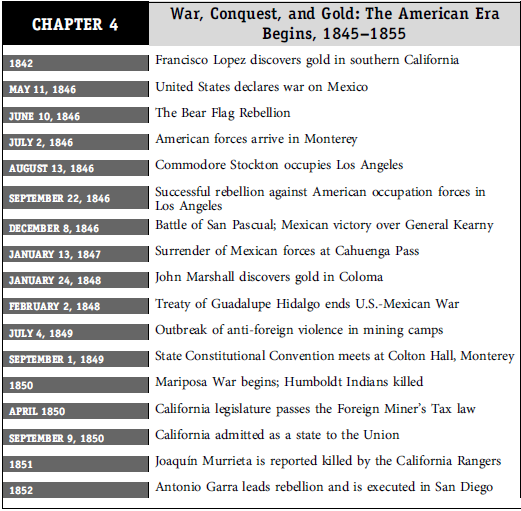4: War, Conquest, and Gold- The American Era Begins, 1845–1855
( \newcommand{\kernel}{\mathrm{null}\,}\)
Main Topics
- The War Between the United States and Mexico
- The Gold Rush
- California Transformed
- Summary
In the 1870s, Hubert Howe Bancroft, a publisher in San Francisco, set out to write a multivolume history of California and dispatched assistants to interview the Mexican residents of the state, who had important memories of the region’s history. Thomas Savage, one of Bancroft’s helpers, interviewed Doña Felipa Osuna de Marron. At the time, she had been a widow for 25 years. She had lived in Californiaas a Spanish and as a Mexican subject and vividly remembered the American conquest of her native town, San Diego.
In 1846, at the beginning of the war, she was married to Juan María de Marron, a rancher who had been appointed the administrator of Mission San Luis Rey properties. Felipa was at the former mission in the summer of 1846 when General John C. Frémont and the American troops arrived, hoping to capture Californio political leaders. The Americans questioned her about where her husband was and who else was at the mission. Don Matias Moreno, the secretary to the California government, was with Doña Felipa when the Americans appeared.

Even though she “greatly feared the Americans who were not disciplined soldiers,” Felipa had the courage to quickly disguise him as a sick cousin, fooling the Americans, who then left. Once they had departed, Don Matias, who had recognized his good friend Don Santiago Argüello who had been riding with the Americans, sent a messenger to catch up with Argüello to tell him to return, so that he could join him. So Don Matias changed sides because his friend had done so.
After this incident at the mission, Felipa went with her husband to their rancho in the backcountry; later, her husband sent her alone to San Diego for safety. She recounted that in San Diego, Don Miguel de Pedrorena, Don Pedro C. Carrillo, and Argüello, along with others, were allied with the Americans. The Californios who remained opposed to the Americans asked her husband to join them and he did so. Hoping to be reunited with his family, he joined Felipa and their children in the pueblo of San Diego, which was then occupied by the U.S. Army. Soon they secured a safe conduct pass to leave town and they fled back to their rancho. There they found the Californios “furious” with her husband, accusing him of working as a courier for the Americans. They threatened to shoot him, but instead confiscated the family’s horses and took the family as prisoners to another rancho. Almost every day, the Californio partisans descended on the rancho to take what they needed, driving Doña Felipa and her family to the verge of starvation. As she recalled, “most of what we had was taken from us, including the cattle that had been given to us by the mission fathers.”
When the war ended, the Californios continued to accuse Felipa and her husband of being pro-American, though they had never fought with the Americans. Their own countrymen finally forced the Osunas to ask for protection from the American commander of San Diego. Felipa and her husband journeyed from the rancho to town, and when they reached the outskirts her husband raised a white flag. They entered the pueblo, leaving their few remaining livestock outside. Felipa reported that some Americans in San Diego were angry at the return of these Mexicans, whom they regarded as enemies, but the Americans did not punish them.
These episodes, recalled by Felipa Osuna in an interview to Thomas Savage in 1878, reveal some of the schisms among the Californios over the American conquest. As evidenced in her testimony, the conquest of California was more than a military one, extending to a struggle between friends and families. The real conquest—the transformation of the economy and society—began a few months after the end of the war with the discovery of gold. Within a year, thousands of immigrants from the United States, Latin America, Europe, and Asia overwhelmed the native peoples and the Californios. Virtually overnight, they created a new society—one that was entirely alien to Felipa Osuna and her family.
Questions to Consider
- What was the role that Californios played in the war between the United States and Mexico?
- How are we to evaluate the Gold Rush as a social, political, and moral event, given its mixed effect on teh traditional cultures of California?
- What has been the legacy of the Gold Rush on people of various ethnic and racial backgrounds?
- What is the larger meaning for California's history of the economic and social changes brought about by the U.S.-Mexican War and the Gold Rush?


